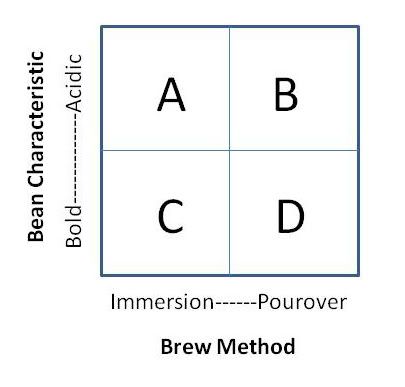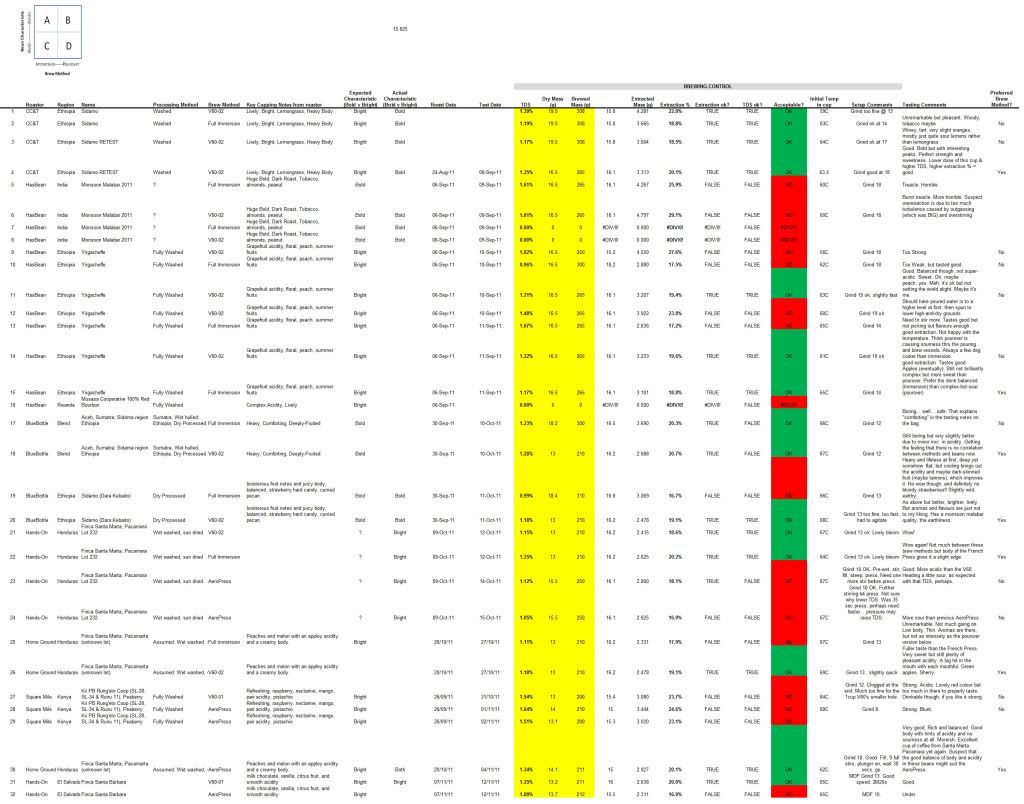A few days ago Cyclone Friedhelm (or Hurricane Bawbag as the Scots have named it) left around 2000 folks in our area with no electricity, floods, ice, snow, and in one case a burnt down house! So in true Scottish fashion we headed over to the home of some friends, got drunk and stayed up late talking bollocks. The electricity came back on at our place today so I'm lying on the sofa with a hangover and just thought I'd write a nice easy post that doesn't require brainwork or standing up.
I've been meaning to write this post for ages. For a few months now I've been logging some of my manual brews. The purpose was originally to provide data to answer a question that came to me a few months back... whether it is possible to match the predicted characteristics of beans to particular brew methods. Beans have many characteristics but I chose to focus on boldness and acidity on the assumption that coffees are either bold or acidic but rarely both. (Actually the experiment soon proved to me that this was a flawed assumption.)
So for example, is a bold, earthy sumatran best suited to a French Press to retain as much of the body as possible? Or conversely, would it be best suited to a pourover, to bring out some of the beans' intrinsic acidity and therefore use the brew method to counterbalance the bold, earthy qualities. Each brew would theoretically fall into one of the following four boxes, and if a particular box gets more 'hits' then that would indicate a brew method fitting well a bean's characterstics.
Once I thought about it, I realised that it was pointless to use coffees that were not brewed correctly as that would skew the results. I needed as way to control the brew, so I could accept or reject each brew. Fortunately the Brewing Control Chart created by Ted Lingle of the SCAA exists precisely for that purpose. I bought a TDS meter to allow me to establish TDS and Extraction Yield (although I've already blogged about the device having limitations).
So, a few months ago I began logging the details of each brew ... the beans, the brew method, the temperature, TDS, Extraction Yield, my tasting notes etc. It didn't take long for me to start learning many things, including:
1. It is not as easy as I had previously thought to brew a coffee that falls into the 'Ideal' range on the brewing control chart. What I had thought was correct was wrong. This is one of the pitfalls of over-reliance on websites like www.brewmethods.com to learn correct manual brewing. Those videos don't help you learn to adjust your technique to the current condition of the beans.
2. The current condition of the beans is constantly changing. I knew that, but I didn't fully appreciate just how much it can affect extraction during manual brewing. For example, the bloom of very fresh coffee would increase extraction, so I would need to agitate the brew slurry less or more depending on freshness and bean gas.
3. Matching brew method to beans based upon boldness/acidity doesn't work. Every day the beans work best in a different brew method, because they are constantly changing. You simply can't say "this bean should always be brewed in a French Press". I had been told that it would probably be the case... but as always I prefer to learn through my own experiments rather than simply being told. There is a lot of opinion (rather than fact) out there and who are we to believe?
Anyway, this post is getting long and I'm getting more hungover so I'll bring it to a close. The main point I want to make is how valuable my brewing log has been in learning how to perform manual brewing. I soon ditched the original purpose of the log, and just used it to record the details of each brew to help me move forward. I added new brew methods. I inserted new columns, deleted others, tweaked the format of my comments so I could refer back to them in future brews, etc etc. It takes moments to fill in, which I do whilst waiting for the TDS meter to take the reading and drinking the coffee.
Here's a jpeg of part of my log.


Pretty! It was really a wonderful blog. Thanks for the provided information.
ReplyDeleteUK coffee grinders